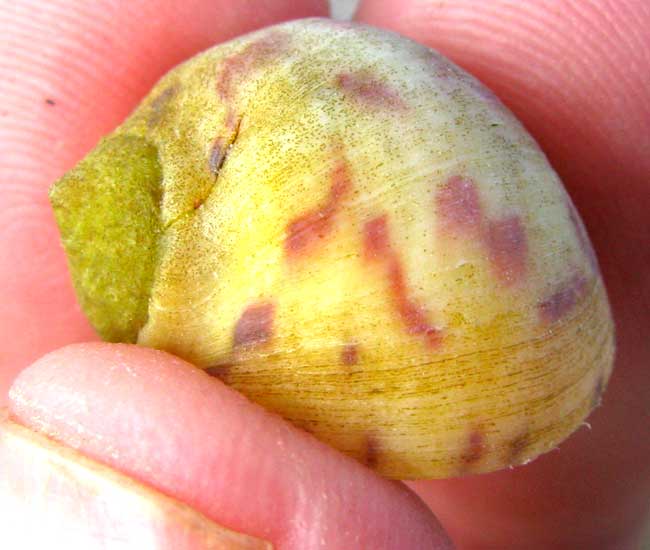Excerpts from Jim Conrad's
Naturalist Newsletter

from the May 22, 2011 Newsletter issued from Mayan Beach Garden Inn 20 kms north of Mahahual; Caribbean coastal beach and mangroves, ~N18.89°, ~W87.64°, Quintana Roo state, MÉXICO
BLEEDING TOOTH ON A ROCK
At the rocky point a few kilometers south of us, algae-darkened limestone rocks emerging at low tide were covered with hundreds of dark, speckled, Four-tooth Nerites, which we looked at a couple of Newsletters ago. Also, there was one individual shell on a wet rock like all the rest, but a little smaller, a little paler, and blotched instead of speckled. He's shown above.
Recalling that the opening at the bottom of the Four-tooth Nerite's shell bore four white "teeth," to see if this one had a different dental formula I turned it over and saw the very different configuration shown below:

The next day volunteer seashell-identifier Bea in Ontario told me that we had a Bleeding-tooth Nerite, NERITA PELORONTA. Anyone looking at the above picture immediately sees where that name came from.
This is the third nerite species we've run into, the first being a mangrove species up at Río Lagartos some years ago. Though I'd never heard of nerites before visiting the Yucatán's shores, it's beginning to occur to me that here they're important coastal mollusks.
Nerites, I find it written, are thought of as medium-sized sea snails. They're found in tropical waters worldwide in the middle and upper intertidal zones, and they are gregarious herbivores. In general they spend their days peacefully grazing alga growing on wet rocks. Those teeth we've seen at the bottom edge of the shells' openings vary from species to species, from many and fine in some species to few and robust in others. Those teeth aren't used in eating, but I can't find mention of any use they may have.
Our Bleeding-tooth Nerite appears to be the most famous of all nerites. Many online stores sell their polished shells as ornaments, and others sell them as colorful aquarium items.